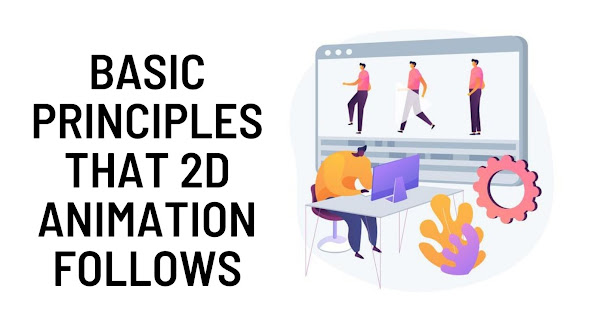You love animation right? Do you know what are the basic principles of 2D animation? You must know this because, before going through anything you must know and learn about its basic principles. So, in 1981 Disney animators Ollie Johnston and Frank Thomas introduced principles of animation that were the core of animation. 12 principles are now widely recognized all over the world and animation works on these principles only.
 |
| Basic principles that 2D Animation |
Squash and Stretch
It is the most fundamental principle of 2D animation. It is said that the non-dynamic movement of a ball doesn't change its volume when it is squashed or stretched. It can be applied on all the simple objects like a ball or a bubble and it said that having an extreme stretch in figure and getting squashed to a degree to design changes. So, what exactly the first principal wants to say is, When an object is in motion or bounced it does not change when it is squashed or stretched.
Anticipation
Anticipation refers to a process that is used to prepare the audience for a particular action and to make that action more realistic to engage the audience. This technique can be used for actions that require less physical strength and it is also used for grabbing the attention of an object that the character is about to pick up.
Staging
It is also known to be theatre and film. The purpose of staging is to attract audience attention and to make a scene more impactful by increasing the importance in a scene and this can be done by various methods such as placing a character in a frame or by the usage of light or shadow. It is based on the principle of focusing on things that are relevant and avoiding something unnecessary.
Straight ahead action and pose to pose
These are two different approaches that are related to the drawing process and they involve an animated frame by frame from beginning to end. Where pose to pose works on the principle of starting withdrawing with few frames and then filling the details later. According to the surveys, straight-ahead action creates better dynamic illusion and is better for or making the illusion of movement and realistic action sequences. Whereas, it is tough to maintain and create exact poses in a way. According to some other surveys push to pose works great for emotional scenes and dramatic scenes where the relation to the surrounding area of greater sequence.
Computer animation
computer animation is something that removes the problem which we were facing when using straight-ahead action drawing. However, computer animation still uses pose to pose because of its merits the use of whiteboard computer animation prioritizes the method in filling the missing sequences automatically and it can be a great thing to apply it to other principles.
Follow through and overlapping action Follow through and overlapping action is a general method for heading two closely related techniques which are responsible for the movement in a more realistic way. It also helps to impress the characters by following the law of physics including the inertia principle.
Slow in and slow out
The movement in the real world done by the objects such as animals or vehicles or even the human body, it needs some time to accelerate themselves or slow down themselves so for this cause, pictures are used near the starting and at the end of any action which creates an effect in order to achieve more movement so that actually looks so real. This principle applies to the characters you are moving between two porous and also to slow down the objects like a bouncing ball.
Arc
So, Arc is one of the most important principles, tends to follow a trajectory moving in a parabolic area. This technique can be applied to two moving objects while rotating any joint or object that is thrown in a parabolic trajectory.
Secondary action
Secondary action is the main action that gives a scene a more realistic look and can help support the audience's engagement. The main important thing about this law is that they stress taking action away from the main action.
Timing
Timing is referred to the number of frames or drawings that are hand-made in order to to take action. This principle is critical for stabilizing characters in motion reaction and mood and it can also be used as a communication between the action.
Exaggeration
Exaggeration is an effect which can especially be used for animation purpose and it depends on whether one seeks a particular style for realism.
Solid drawing
The principle of solid drawing said that in three-dimensional space, we can give account forms to the solid drawing by giving them volume and weight. For classical animation, we use solid drawing to sketch balance, light, and shadow.
Appeal
The appeal is something that corresponds to what it would be in charisma. If a character is not looking sympathetic then it can also be appealing that the viewers feel that the character is real and interesting. So, you can follow several tricks to make a character connect better with your audience because captivation for appeal is the most important part the animation wants.
Comments
Post a Comment